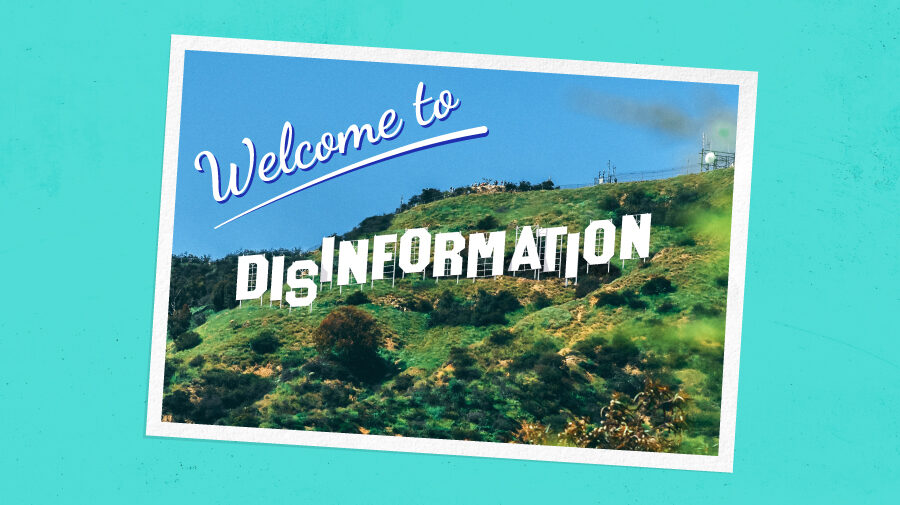Journalists covering falsehoods, conspiracy theories and white supremacy face enormous challenges. The most immediate — and vexing — is that reporting on these problems can inadvertently spread false information to entirely new audiences, normalize dangerous messages and incentivize future harms. To complicate things, strategies for responding effectively to disinformation can be counterintuitive; the risks of amplification are often obscured by well-intended efforts to help. We, along with a number of other researchers, have worked closely with journalists over the last six years to develop best practices for reporting on mis- and disinformation. Today, journalism is far from perfect; but on the whole, journalists are more careful about what stories they tell and how they tell them.
A recent invitation to a summit organized by the nonprofit Pathos Labs — which paired disinformation experts with showrunners and writers to discuss possible storylines about radicalization, conspiracy theories and other harms — helped us see how these best practices could apply to the television and movie business. Storytelling in the news media and storytelling in entertainment media are different, of course; the purpose of the news media is to inform, while the purpose of entertainment media is to entertain. The directive to inform the public gives journalists enormous power. What reporters cover (or don’t) shapes public discourse. But the directive to entertain the public is something else entirely. The stories told by entertainment producers go beyond “just the facts.” They transport audiences into whole other worlds.
As Melanie C. Green, a social psychologist at the University at Buffalo, has shown, the process of transportation is central to narrative persuasion. The more transported someone is by a story, the more likely they are to be persuaded by its messages. Showrunners and writers are quite literally in the business of maximizing narrative transportation. When they are considering stories that feature falsehoods, extremism and identity-based violence, they must therefore proceed with extreme caution.
Like journalists, entertainment producers won’t be able to mitigate all amplification risks. Sometimes the best outcome of telling risky stories will be less harmful amplification, not zero harmful amplification. Here are some lessons we’ve learned and some associated tips — modified from journalism best practices — for making better storytelling choices.
Lesson #1: The most obvious place to point the camera often narrows the story
When confronted by major news stories such as the Capitol insurrection or the growth of QAnon and other conspiracy theories, the logical place for reporters to direct their focus is to the insurrectionists or hardcore believers. This is understandable; these are the people doing the most obviously harmful — and therefore most newsworthy — things.
However, focusing solely on the perpetrators causes problems. First, it reinforces the myth of a “lone wolf” and erroneously places all the blame on individuals, rather than the cultural and technological systems that allowed — or even encouraged — a harmful event to happen. Individuals might be personally responsible for their actions. But the broader context is what makes those actions possible. Second, when individuals are framed as the problem, the solutions to those problems are also typically framed in terms of the individual: if we could just say the right thing or stage the right intervention, we could fix the issue. But the issues that actually need fixing are structural. The third problem with zooming in on extremists and conspiracy theorists is that it undercuts well-rounded storytelling; so many histories, people and issues are left out when only the most obvious story is being told.
Tip for showrunners and writers: When possible, approach stories about white supremacy and radicalization from the side. The most obvious story to tell about QAnon, for example, is through the eyes of a believer, or family members who have lost loved ones down the rabbit hole. But stories that aren’t obviously about QAnon are also critical to understanding, and in fact pushing back against, QAnon. Try to include storylines that speak to the broader context, including the cultivation of mistrust in institutions that can develop over a person’s lifetime. Relatedly, efforts to inoculate people from belief in conspiracy theories such as QAnon shouldn’t merely highlight damaging personal consequences. They should also seek to cultivate trust in institutions, which could be shown by including storylines about hard-working healthcare professionals, government workers or journalists.
Lesson #2: The more nuance you bring to white supremacist characters, the more risks there are
Over the last several years, mainstream journalists have sought to explain the growing visibility of white supremacy in the US — and have often struggled to balance the news value of these stories with the dangers of amplification. Many news stories have highlighted white supremacists’ harmful beliefs alongside the “normal” and relatable parts of their lives, including shopping trips and interactions with their kids. While journalists might think they’re presenting a more complex portrait of the person they’re profiling, they’re actually risking the normalization of extremist ideology and are implicitly forwarding a “both sides” argument in which white supremacy is framed as just another lifestyle choice.
Further, all the effort and column space (or airtime) that goes into humanizing white supemacists very often results in less effort and less column space (or airtime) devoted to the consequences of white supremacist ideology — typically resulting in disproportionate focus on white characters and their experiences and inner lives, and next to no focus on the marginalized communities directly and indirectly harmed by white supremacy.
Tip for showrunners and writers: If you include “bad example” characters — particularly white supremacists, but also people who end up radicalized in other ways — make sure that the character is there to reveal more than the self-explanatory claim that “these kinds of people exist.” Never include these characters for mere shock value. Never assume that by having them say racist or extremist things, you will open your audience’s eyes to the dangers of these beliefs. Reflect on whose screen time will be cut — or not included at all — because of time and energy devoted to these characters, and make sure there’s parity among characters who do harm, characters who do good and characters who are directly affected by the harms you’re portraying.
Lesson #3: Light doesn’t reliably disinfect
Within journalism, the belief that calling attention to social problems will help minimize or even solve those problems — often stated as “light disinfects” — is deep-seated. Sometimes these efforts don’t work as expected.
When light successfully disinfects, it’s typically because the storyteller and audience are in basic agreement about what’s good for society and what’s detrimental. But when there’s a lack of agreement, light isn’t a disinfectant; it’s publicity, helping spread the illuminated messages to wider audiences.
The “light disinfects” belief also relies on the assumption that the public is unaware of the harms being exposed. In the case of white supremacy, some populations — particularly white people — remain sheltered from its pervasiveness. But those most affected by white supremacy do not need to be told that white supremacy exists. Efforts to plaster the newspaper pages and airwaves with white supremacist images and messages in order to say “this exists and is bad” forces audiences already threatened by those images and messages to see more of them.
Further, research on the relationship between hate crimes and politicians’ bigoted rhetoric suggests that the amplification of white supremacist language may incentivize additional white supremacist violence. Couple this with more nuanced — and therefore more sympathetic — portrayals of white supremacists in storytelling, and the dark side of light is intensified.
Tip for showrunners and writers: Even if your intention is to prevent radicalization or belief in a particular conspiracy theory, consider how someone might use your story to recruit, justify or merely sand the edges off extremist ideology. Do what you can to make that more difficult.
Lesson #4: Tragic personal narratives aren’t automatic public services
With the rise of conspiratorial thinking since the start of the Covid-19 pandemic, a new genre of “down the rabbit hole” storytelling has emerged within journalism. These stories speak to the profound and often family-destroying consequences of disinformation and radicalization. They often linger on the family members’ distress, and on the slow but steady process by which someone’s mother or aunt or best friend transforms into someone unrecognizable.
Parallels with cults are frequently highlighted; so are discourses around deprogramming. Similar to the belief that light always disinfects, these stories often implicitly suggest that calling attention to the process and effects of radicalization will help solve the problem: they will make people more empathetic, more media literate and more prepared to intervene if someone they know becomes radicalized. In some cases, that might happen. But positive outcomes are hardly guaranteed.
These stories — particularly when they play up a sensationalist cult angle — are just as likely to encourage rubbernecking and the general sigh of relief that “it could have been my family.” In cases where audiences benefit from these stories, the risks of amplification may be outweighed. But when the primary outcome is morbid fascination or straight-up entertainment, that cost/benefit is much trickier to assess.
Tip for showrunners and writers: Consult with a range of experts, particularly disinformation and media manipulation scholars. Echoing an earlier tip, if you’re focusing on a dangerous subculture with white supremacist or antisemitic beliefs, make sure you’re not just talking to white people about what the community is about and what harms might result from the amplification of its messages. Not only can these experts help you avoid accidentally producing a recruitment video, they can help identify where the imperative to entertain audiences might undercut your goal of educating them.
This is an incomplete list; each new story will require a nuanced, context-specific approach. The one main takeaway — the most difficult and most important lesson from our work — is that motives matter less than outcomes. You can’t control all the outcomes in your storytelling. But you can control some of the variables, choices that can have enormous consequences for people’s families, those who might be teetering on the edge of radicalization, and democracy itself.






